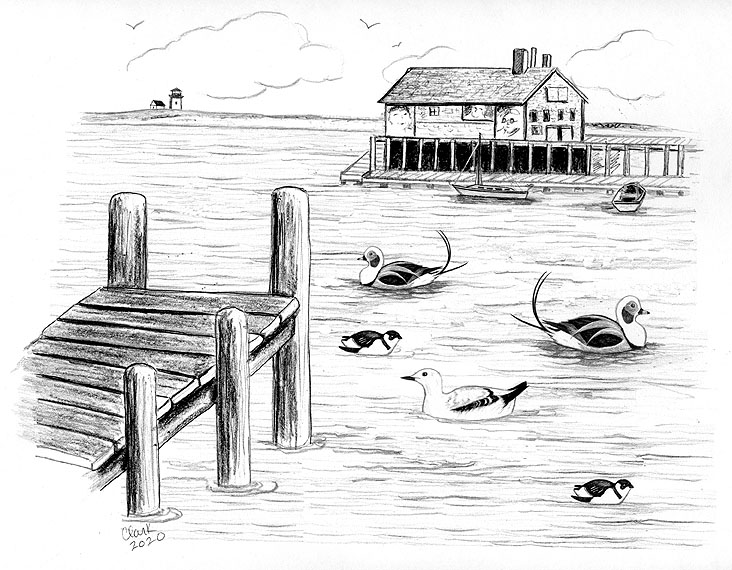
Easy Winter Birding in Provincetown:
I’m not alone when I say that Provincetown is one of my favorite places to visit. The town has history, character and characters…especially characters. But unlike most of the world, my preferred time of year to visit Provincetown is in the dead of winter. There’s no traffic, the parking is free and my favorite restaurant is still open. Plus, there are birds here that you might not see anywhere else on Cape Cod, and that’s the real reason to go.
For such a small area, Provincetown has an assortment of really good birding locations. There’s the Beech Forest, Herring Cove, Race Point and trails through the dunes, but all of those places take a bit of effort to explore. If you are short on time, have walking issues or are like me, just plain lazy, the best birding spot is Provincetown Harbor. Simply drive out onto MacMillan Wharf* and from the comfort of your car you can search the harbor for ducks, loons, seabirds and unusual gulls. (*Several websites and maps refer to MacMillan Wharf as MacMillan Pier, but I’ve never heard any human being call it a “pier.” This is Provincetown, not Santa Monica.)
On our most recent visit, the conditions were ideal. The sun was bright, the tide was high, the wind was light and the temperature, for winter, was bearable. First to greet us was a flock of pigeons, cooing and huddling together for warmth on the roof of a whale watching kiosk. There were lots of Common Eiders feeding around the pilings, and just past the eiders was a gloomy Common Loon. In the summer these stately birds are striking and loaded with attitude, but in the winter they become dull and look totally bored with life. I even tried telling this loon a few jokes, in hopes of cheering it up, but it just stared at me. Tough crowd.
The contrast between the summer and winter loons is extreme, but not nearly as extreme as the next bird we found. In breeding plumage, the Horned Grebe has a rich cinnamon neck and body, a dark black head with flowing golden ear tufts (“horns”), plus crazy red eyes. All of that showy plumage is currently gone. This time of year the bird is mostly drab gray, although the red eyes are still there and still crazy. Speaking of eyes, we soon came upon a Common Goldeneye. There is no bland winter plumage for these ducks; the males look just has dapper now as they do in spring. And with the bright sunshine, we could actually see the goldeneye’s golden eyes.
Next we were treated to the sighting of a rare Black Guillemot (pronounced, “gill-le-mot,” or something like that). Guillemots are alcids (seabirds) that breed in nearby Maine. However, this particular bird belongs to a subspecies that is normally found in the High Arctic. Like most of the birds we have discussed so far, guillemots have a different plumage in the winter, but this bird takes things up a notch. In the summer it is all black (save for white wing patches), but come winter it turns nearly all bright white with just a bit of black showing here and there. A “white” Black Guillemot sounds like an oxymoron, but that’s bird watching for you.
Male Long-tailed Ducks (formerly known as Oldsquaws) also have distinctive winter plumages and many birders actually think they look better in the winter. As the name implies, male Long-tailed Ducks feature two five-inch-long (they seem longer) tail feathers protruding out of the back. On this day, the harbor was active with several males, each one giving its signature “owl-owllet” call, presumably to get the attention of the disinterested ladies. Speaking of ladies, as I watched the long-tail show, I noticed my wife was waving to get my attention. Often this means she has found something good and as usual, she had. Dovekies!
Dovekies are tiny seabirds that breed each summer in massive colonies in faraway Greenland. Weighing less than the pigeons on the whale watching kiosk, the little black and white Dovkies spend the winter out at sea, only coming near land when driven in by storms. I was trying to snap a photo of the energetic Dovekies, when I realized my wife was headed back to the car. It was my cue that she was cold or hungry or both. Probably both.
For decades, frozen birders have been thankful that Provincetown’s iconic restaurant, Napi’s, stays open all winter long. Napi’s has exactly what we need: good food, a funky atmosphere and even a vegetarian menu. But on this visit there was one thing missing. Sadly, Napi passed away a few weeks earlier and it was a bit strange not seeing him. We offered our condolences to his wife, Helen, who seated us next to the fireplace. We all chatted and swapped Napi stories as we slowly warmed up. Napi was a true character and quite a talker. He would routinely tell me the same assortment of bird stories on every visit. I did my best to pretend I hadn’t heard them before. Now I wish I could hear them one more time.
If you want to see some different birds this winter, you should make the drive to Provincetown and check out the harbor. It’s best to go when the sun is out and the tide is high. Also, make sure the wind is light or you won’t even be able to open your car door. After watching the birds for a while, you will eventually become cold and probably hungry. Where you go next is up to you, but I have a suggestion. It’s a place where the food is always good and the atmosphere is always funky, but, alas, the bird stories won’t be the same.